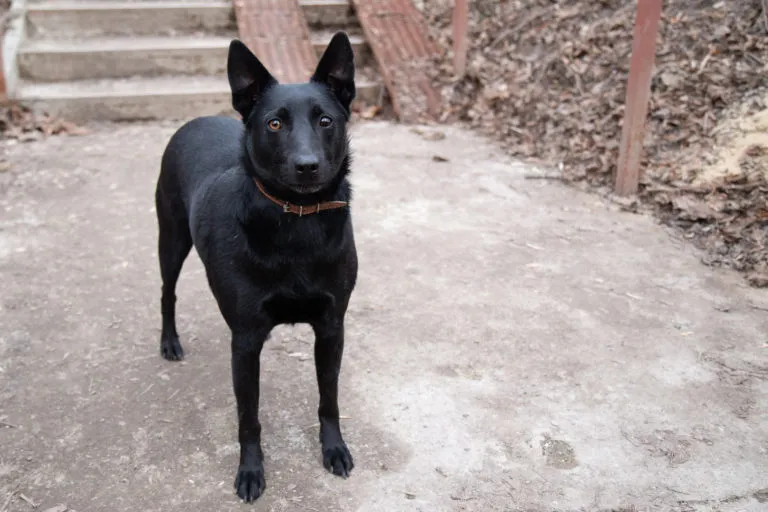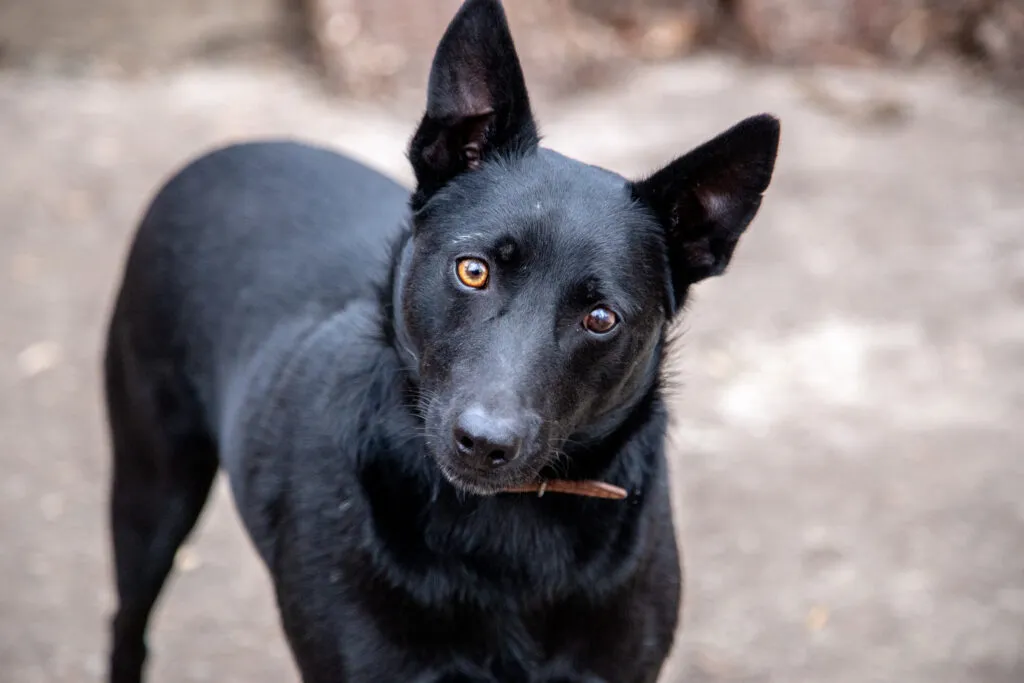Medium Size Poodle
A Rare Hunter from the Far North: Despite the similarity in names, the Black Norwegian Elkhound is a distinct breed, though closely related to the Grey Norwegian Elkhound. However, this dark northern hound is much rarer to encounter.

© Garmon / stock.adobe.com
Their intelligence and affection make training the Black Norwegian Elkhound surprisingly smooth
The Black Norwegian Elkhound visually resembles a typical Spitz, featuring a compact, square-shaped body with erect ears. Like other elkhounds, it carries its tail rolled over its back from adulthood. It’s smaller and more agile than the grey counterpart, weighing about 18kg with around 47cm shoulder height.
As the name suggests, this dog’s short fur is black, though white spots on the paws and chest are allowed by the standard. The eyes are also dark. The coat is dense and close-fitting, consisting of a rough topcoat with a soft undercoat.
Among the three northern elkhound breeds (Black Norwegian Elkhound, Grey Norwegian Elkhound, and Swedish Elkhound), the black one receives the least attention. Nonetheless, this nimble and friendly hunter is an attractive breed for many dog owners.
Its origins, along with those of the Grey Norwegian Elkhound, date back a long time. These confident Spitz-type dogs are considered ancient breeds, with a similar dog appearance traced back to the Stone Age in Scandinavia.
The Black Norwegian Elkhound is a modern variant of the grey one and has been recognised as an independent breed since 1877. Elkhounds are hunting dogs – specifically for moose, but also for other purposes. A hunting advantage of the black variety is that they are highly visible against white snow. Additionally, these intelligent canines have always been used as guard dogs or livestock guardian dogs.
 © Garmon / stock.adobe.com
© Garmon / stock.adobe.com
This breed forms a close bond with its people and is very loyal. Once you make a friend of one, it will be devoted to you. However, this does not mean this autonomous elkhound will be submissive.
Outdoors, these dogs are lively, curious, and open to all shared adventures. A well-exercised Elkhound also enjoys cosy cuddling on a quiet afternoon. They are playful, brave, and very intelligent. Like many Nordic dogs, they make good “alarm systems” but are only moderately effective as guard dogs.
While they will alert you loudly and persistently to strangers, they might end up wagging their tail at a potential intruder. They don’t always get along well with other dogs, so proper imprinting and socialisation are crucial.
The intelligence and people-orientation of this breed make its training relatively straightforward. They enjoy working with “their” people and will follow commands as long as they find them sensible. Bear in mind their stubborn streak as independent hunters during training. Be consistent and pay special attention to recall and bark control.
Violence and harshness have no place in training these sensitive dogs. They usually respond quickly and strongly to harsh words or reprimands, so use them sparingly. Positive reinforcement is the best way to motivate them, and even clicker training can be very effective.
Attending puppy school helps enhance their social nature, which can sometimes be a bit combative with other dogs. It’s also worth considering dog school training sessions – find a suitable dog school for you and your companion before your puppy arrives.
This breed is generally considered robust and, given responsible breeding, largely free from genetic diseases. Dogs in good health can live up to 13 years. These energetic dogs need a diet rich in meat. Look for food where meat is the main ingredient and ideally grain-free. The energy needs of your dog depend on its constitution and activity level, so keep an eye on its slim waistline and adjust daily portions if necessary.
Small snacks in between can quickly add up – so be mindful. Healthy snacks can include chewy dried items, sugar-free dental care treats, or freeze-dried meat treats. Always ensure water is available at all times.
The Black Norwegian Elkhound’s fur is essential in the harsh northern climate, providing excellent protection from heavy autumn rain and icy winds. Help your companion keep its coat in good condition by brushing it every few days to remove dead hair.
During moulting seasons, daily brushing can help reduce shedding in your home. Once dried, dirt can usually be brushed out of the fur. Bathe your dog only when necessary, using a mild dog shampoo. Check the ears regularly during grooming and clean them with a mild cleanser if needed.
Some owners choose to brush their dog’s teeth with a canine toothbrush and paste, a good method for preventing tartar and related issues into old age. Introduce this routine to puppies early. For older dogs, occasionally check and trim the claws if they no longer wear down naturally, using a canine claw trimmer.
Although traditionally used for hunting moose and bears, as well as smaller animals like foxes, the black Norwegian Elkhound is a versatile all-rounder. It enjoys outdoor activities and has great endurance, making it a suitable jogging partner after proper training.
Outdoor activities are more relaxed if your dog responds to recall commands, preventing it from chasing every rabbit it sees. While they may not enjoy fetch games, these intelligent and energetic dogs can be passionate about agility sports and scent work. They can also be involved in rescue work.
Some elkhound owners have positive experiences with their dogs as visiting companions in nursing homes, bringing joy to the residents. Try out various activities together – the possibilities are vast!
A Black Norwegian Elkhound suits active people who love the outdoors and can keep their dog engaged. Apartment living is possible if there is enough space and the dog gets plenty of exercise. Beginners can manage this breed’s training if they understand its hunting instincts and tailor their approach accordingly.
This breed can be a great companion for children and, if introduced as a puppy, can sometimes live amicably with cats. Otherwise, the dog might see the cat as prey. Small animals like rabbits are not ideal housemates as they can trigger the dog’s predatory instinct.
An elkhound can also sleep outside, which might be a good option in summer for these heat-sensitive dogs, but they need close family contact and dislike being alone. Consider the one-time and ongoing costs, and ensure you can devote several hours daily to your new companion. Plan for care during illness or holidays – many destinations & hotels now welcome dogs.
Regardless of which Norwegian Elkhound has captured your heart, these large game hunters from the north are rare outside Scandinavia, especially the black variety. Contact clubs for Nordic dog breeds, as they may connect you with breeders domestically or abroad. Expect waiting times and long distances to your desired puppy, with only around 120 puppies born annually in Norway.
Finding a fully grown Black Norwegian Elkhound outside Scandinavia is nearly impossible. It is very unlikely to find such a dog through regional rescues – however, a visit might be beneficial if you are open to other breeds. For finding an adult dog, consult Nordic dog clubs for contacts with elkhound rescue organisations.
We wish you much delight with your Black Norwegian Elkhound!
Fans of the Bearded Collie agree that those who aren't familiar with this dog breed simply have to get acquainted with it. And those who have experienced how a Bearded Collie bolts across meadows with its flowing fur, how it rolls around full of energy and joy and how it attentively and observantly takes into account its owners wishes become simply addicted to this original dog breed and its unique charm.
The Goldendoodle isn't a breed, but a pairing between Golden Retrievers and Medium or Standard Poodles. Marketed as a low-maintenance dog for allergy sufferers, this hybrid is enjoying increasing popularity amongst dog lovers, similar to the Labradoodle.